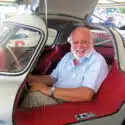Doug Nye: Here’s how to drive a Caterham Seven around Goodwood race circuit
“A day at Goodwood in assorted Sevens provided wonderful escape”
It’s been a busy month. But in between the usual bouts of frenzied research and writing, a day spent haring around Goodwood in assorted Caterham Sevens with the company’s chief instructor Alex Read and his team provided wonderful escape…
After blazing around the familiar old circuit with my little remaining hair on fire, being urged by the team’s demonstrably nerveless young experts “Aim straight at the middle board! Max brakes! Off! Turn in now! Power!!!”, I wanted to watch a true pro at work. The engaging BTCC driver Jake Hill – a genuine racing-cars-of-all-ages fan – was with us and I asked him to take me round.
After a battle to insinuate my unfoldable body through the rollcage and down into a lightweight 360hp-per-ton 2-litre Caterham 360R SV, Jake asked “How do you want me to drive?”. “Flat-out – as if you’re going for a time, despite all this ballast”. So he did.
It was joyous. Since the mid-1960s I’ve accumulated probably hundreds of laps at Goodwood, in everything from my first sighter in a Motor Show test day Austin-Healey 3000 to Jaguar Cs, Ds and Es, Ferrari 250GT LWB, SWB, GTO, 330LM/B and Formula 1 Dino 246, through Lotus Elan, 11, 15 and 30 to Renault Savanna estate, assorted Land Rovers and even the circuit’s then extremely cranky old ’60s ambulance.
Where the instructors’ advisory “brake at the 100m board” into Woodcote had become my 80-90yd, Jake remained lickety-split on the power until 60-65 – brief left-front tyre protest puffing smoke, then understeer towards the approaching outer kerb, and ‘Wham!’ right-lock, power on and out towards the chicane.
Fierce trail-braking right-handed and deep towards the left-hand apex. Flick left, balance to the kerb, power already on and up through the gears past the pits. Deep into Madgwick, centre-track. Bury the brakes, off and flick right, power sliding the first apex, drifting wide before the natural line clips the second, accelerating to the left-side verge for the right-hand curve at Fordwater which is taken absolutely flat-strap. Hurtle on towards the right-left St Mary’s Ess – having previously given everyone present a good rollocking for using the right-hander’s groundless ‘No Name’ tag in my (OK, pompous) presence – a pet hate of mine. Pah!
“Power already on and up through the gears past the pits”
Straight-line brake for that right-hand entry, and power! Slam-bam braking for St Mary’s much tighter, dipping left-hand exit. Oomph against the seatbelts, and Jake’s flicked this little sled of a car left to clip the apex kerb, power slide wide, clip the right-verge mini apex halfway towards Lavant’s double right-hander. Wide towards the outside verge, more heavy braking, and “In” to the entry apex, wide out to the midpoint kerb, power and in again to the exit kerb. Up through the ’box onto the dog-leg Lavant Straight. Well over 100mph aiming – like the Luftwaffe – for the former Royal Air Force aerodrome squadron office which is today’s Super Shell building. And back to Woodcote for another 60-65yd braking adventure.
Goodness – that was fun. Caterham ran two Sevens for us with alternative set ups, one on modern Toyo near-slick tyres, the other on Dunlop CR65L historic racers “…to make it handle more like a Maserati 250F or 300S”. The difference in grip and handling was unmistakable, modern efficiency and lap time versus familiar old-time ‘feel’ – admittedly slithery, but somehow friendly…
My blind spot at Goodwood is that darned chicane. Somewhere deep inside is the ‘crump’ we heard when Jo Siffert got it wrong just here and slammed his Rob Walker Brabham-BRM straight into the left-hand apex wall – which in 1965 was solid brickwork – right in front of me. His Brabham’s chassis ended up bent like a banana in the vertical plane, about 3in ground clearance at nose and tail – a full foot amidships. Quite how ‘Seppi’ escaped serious injury or worse staggered everyone there that day.
Over the years I’ve grazed that same apex at least three times, never doing worse than scuffing paintwork or whitening the left-front tyre sidewall but hey, in recent years that apex has been just a rubber tyre stack or the polystyrene used for the Members’ and Revival Meetings. With somebody else’s car in your hands any caring soul remains wary there – but not great against the stopwatch.
Doing some laps with a very well wired-up friend saw him getting close to Jake’s late-braking marks, but on some laps – I felt – then leaving himself scrabbling to save the situation which left him late back on the power. “Better to be slow in – fast out” I pontificated, recalling my boyhood reading of Piero Taruffi’s The Technique of Motor Racing and Jenks’s The Racing Driver – not to mention the 1972 Castrol Racing Drivers’ Manual which I wrote with dear old Frank Gardner.
Of course, I did not confess that my track technique is more a case of “slow in – slow out”, but never mind, just sometimes, pride does bubble to the surface.
What a day with those Caterham boys. It was, apart from impressing me no end, a welcome break in the working week.
Doug Nye is the UK’s leading motor racing historian and has been writing authoritatively about the sport since the 1960s

